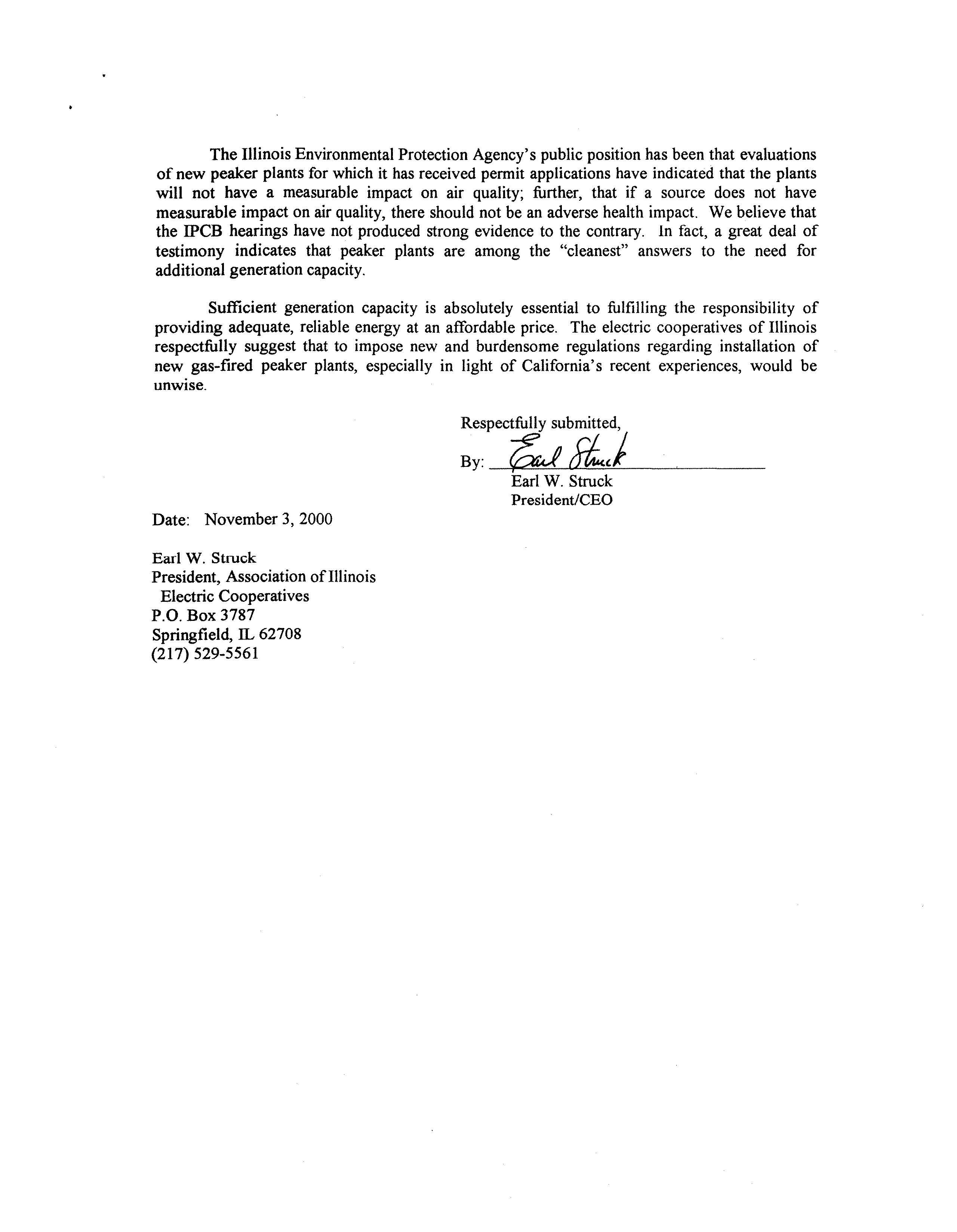RECEIVED
BEFORE THE ILLiNOIS POLLUTION CONTROLBOARD
CLERK’S OprrCp
NOV06 2O0~
IN THE MATTER
OF:
)
STATE
OF
)
POII~tj0t,Co~t~0
Board
NATURAL GAS-FIRED,
PEAK LOAD
)
ROl-lO
ELECTRICAL POWER GENERATING
)
FACILITIES (PEAKER PLANTS)
)
COMMENTS OF THE ASSOCIATION OF ILLINOIS ELECTRIC COOPERATIVES
The Association ofIllinois Electric Cooperatives
is the statewide service organization for
Illinois’
27
electric
cooperatives.
The
25
electric
distribution
cooperatives
provide
electric
service to more
than 600,000 Illinoisans,
located primarily in rural areas of 86 of the
state’s
102
counties.
Two generation and transmission cooperatives supply wholesale power to the majority
of the state’s distribution cooperatives.
Illinois electric
cooperatives are not-for-profit organizations.
Each electric cooperative
is
governed by a
board of directors,
nominated and
elected
by the member-consumers who receive
electric
service
from
that
cooperative.
Local
control
through
the
locally-elected
boards
of
directors ensures all cooperative member-consumers a voice in rates,
policies, member rights and
other matters relating to the operation of their electric cooperative.
First
organized
in
the
1930’s
and
1940’s,
Illinois
electric
cooperatives
today
remain
dedicated to
providing an adequate
supply of electric
power at the most reasonable cost possible
to ensure the economic prosperity and well-being oftheir member-consumers.
The
1997 Illinois
electric
deregulation
law
recognized
the
unique
nature of electric
cooperative
and
municipal
electric
systems
--
both
operate
on
a
not-for-profit
basis
and,
in
each
instance,
the
systems’
consumers
are also the owners of the
system.
Article XVII of Illinois’
deregulation law grants
co-ops
and
municipal
systems
“local
control”
over
decisions
relating
to
a
deregulated
marketplace.
Since the enactment ofthat law,
each electric cooperative board
has been diligently
studying how to
best serve their member-consumers in the new marketplace.
Prompted
in part
by price volatility during the summers of
1998
and
1999,
a number of cooperatives
have taken
steps to secure
additional generation
capacity.
Two
Illinois
cooperatives
have
recently
announced
plans
to
increase
coal-fired
generation, using advanced “clean
coal” technologies.
Several other
cooperatives
have decided
to utilize natural-gas-fired peaker plants.
Electric cooperatives
--
local organizations in the truest
sense
--
are committed to being good
neighbors.
Where peaker plants have been utilized,
it has
been in
response to the needs
of the
co-op’s
retail
member-consumers.
In
each
case,
planned
peaker plants
have been located in
sparsely-populated and remote rural downstate areas, without
objection from local residents, and with the support of local government.
The Illinois Environmental Protection Agency’s public position has been that evaluations
of new peaker plants for which it
has received permit applications have indicated that the plants
will
not
have
a
measurable
impact
on
air
quality;
further,
that
if
a
source
does
not
have
measurable impact on
air quality, there should not
be an
adverse health impact.
We believe that
the
1PCB
hearings have not produced strong
evidence to
the contrary.
In fact,
a great deal
of
testimony
indicates
that
peaker
plants
are
among
the
“cleanest”
answers
to
the
need
for
additional generation capacity.
Sufficient
generation
capacity
is
absolutely
essential
to
fulfilling
the
responsibility of
providing
adequate,
reliable energy at
an affordable price.
The
electric
cooperatives of Illinois
respectfully
suggest
that to
impose
new
and
burdensome
regulations
regarding
installation of
new
gas-fired
peaker
plants,
especially in
light
of California’s
recent
experiences,
would
be
unwise,
Respectfl.illy submitted,
By:____
Earl W. Struck
President/CEO
Date:
November 3, 2000
Earl W.
Struck
President, Association of Illinois
Electric Cooperatives
P.O.
Box 3787
Springfield, IL 62708
(217)
529-5561


